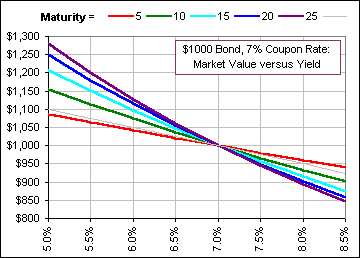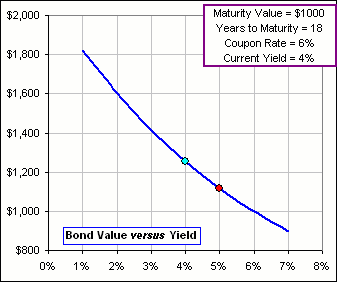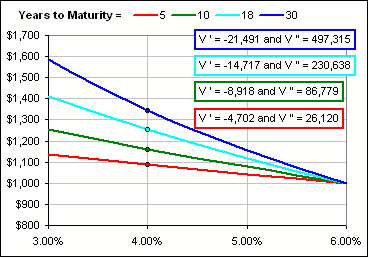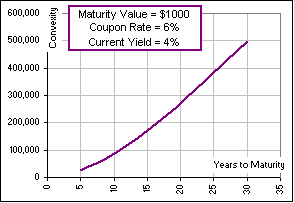| Bonds V and convexity: a continuation of Part IV |
Here we consider Bond Convexity ...
>Huh?
Patience!
When we first talked about Bonds, we considered how
the Bond Value varied with the Years to Maturity, Yield, etc., as in TABLE 1:
and, in particular, the dependence upon Yield (as in Figure 1.) |  Figure 1 |
Letting
B = maturity value of the bond (in dollars)
y = R/m = yield per period (period may be years or months)
c = the coupon rate per period (which may be years or months)
n = mN = the number of periods to maturity (n = years x coupons_per_year)
then the Bond Value is just the Present Value of all the coupons PLUS the Present Value of the Value at Maturity, namely:
(1) V = B { (1+y)-n + c Σ(1+y)-k }
where Σ means the sum of terms, from k = 1 to k = n.
>And what about TABLE 1?
There's a formula for the sum of the series in (1), namely
Σ (1+y)-k
= 1/(1+y) + 1/(1+y)2 + ... + 1/(1+y)n =
{1 - (1+y)-n} / y
and Table 1 uses that formula. Indeed, we can rewrite (1) like so:
| (1A) V = B { (1+y)-n + (c/y) [1 - (1+y)-n] } where y is the yield, n is the number of years to maturity, c is the coupon rate and B is the Maturity Value. |
Anyway, we'll use (1) to determine the Rate of Change of V with respect to y (the first derivative, in Calculus-speak) and determine the relationship between this Rate of Change and the Macauley Bond Duration, BD, like so:
(2) (1/V) dV/dy = -1/(1+y) { n(1+y)-n + c Σk (1+y)-k } / { (1+y)-n + c Σ(1+y)-k } and
(3) dV/dy = -V/(1+y) BD
or
| (3A) dV = -[V/(1+y)] BD dy (which gives a change of V, that's dV, in terms of a change in Yield, that's dy. |
and where
(4) BD = Bond Duration = { n(1+y)-n + c Σk (1+y)-k } / { (1+y)-n + c Σ(1+y)-k }
As you may imagine, there's a magic formula for the sum of the series, so we'd get:
| (4A) Macauley Bond Duration: BD = (1+y)/y - {1+y + n(c-y)} / {c[(1+y)n - 1] + y} where y is the yield and n is the number of years to maturity and c is the coupon rate. |
>zzzZZZ
This is just a review of what we've already talked about in earlier tutorials. I haven't got the Convexity yet!
First we'll stick some numbers into the above equations, with an example ... like so:
Current Yield: y = 4.0%
Years to Maturity: n = 18 years
annual Coupon Rate: c = 6%
then we get from (1A) the Value of a $1K Bond, namely $1253.19 and from (4A) the Bond Duration: BD = 12.21 years.
>Huh?
We used equations:
(1A) V = 1000*((1+y)^-n + (c/y) *(1 - (1+y)^-n))
(4A) BD = (1+y)/y-(1+y+n*(c-y))/(c*((1+y)^n-1)+y)
all of which is contained in this calculator ... as well as dV/dy, from (3):
|
The current situation is shown is Figure 2.
>The blue dot?
>The red dot?
>$1116.90? Where'd that come ...?
|  Figure 2 |
|
>Down with Macauley! Down with Bond Duration! Down with ...!
Behave! That brings us to ... >Don't tell me! Convexity!
|  Figure 3 |
Yes, at 4% it's dropping at the rate of $147.13 for each percentage increase in Yield.
But that rate decreases above 4% and, at 5%, is only $126.05 (which we got with that calculator, above).
That curvature is Bond Convexity, which describes the convex shape of the curve.
>That makes an average rate of (147.13 + 126.05)/2 which is ... uh ...
An average of $136.59 which is much closer to the actual drop of
$136.29.
>So why not use the actual Value at 5% rather than estimating 5% by extrapolating from 4%?
Beats me. However, if one wanted to see how convex the curve is at, say 4%, then that calculator says
dV/dy = 14713 (so a 1% increase would mean dy = 0.01 so dV = 14713*0.01 = $147.13).
Now try the calculator with Years = 18, 12, 8, 6, 1 and watch the convexity decrease.
>Or I can look at Figure 1 and see that the curve gets straighter as Years to Maturity is reduced.
|
Yes, that's true. Do you want a formula for convexity?
>Sure. Why not? Okay, it's the rate at which dV/dy changes. Indeed, it's d{dV/dy}/dy = d2V/dy2, so we need to differentiate dV/dy = -V/(1+y) BD = -V/(1+y) [ (1+y)/y - {1+y + n(c-y)} / {c[(1+y)n - 1] + y} ] >I changed my mind. Let's forget the differentiation, okay?
|  Figure 4 |
>Aah, I see an error. Do you?
Where?
>For Years = 18, the value of V ' is shown as 14,717 so that ...
So for a 1% change (that's dy = 0.01), we'd get dV = $147.17 and ...
>Yet you got dV = $147.13, earlier.
Mea culpa. Earlier, I went with the calculator values (to two decimal places), as in BD = 12.21, but in Figure 4, I used Excel and retained more decimal places, using BD = 12.21355 and that accounts for the difference. Besides it's only four cents. Your 2 cents and my 2 cents.
>Don't blame me for your 4 cent error!
Okay, here's something interesting. We can expand V(y+dy) in a series like so:
V(y+dy) = V(y) + V '(y) dy + V ''(y) dy2 / 2! + V '''(y) dy3 / 3! + ...
and, if we retain only the terms up to the second derivative, we'd get the approximation:
V(y+dy) - V(y) = V '(y) dy + V ''(y) dy2 / 2
and, using y at 4% and y+dy at 5% (as in our example, above), we get (picking V ' = 14,717 and V '' = 230,638 from Figure 4):
dV = V(0.05) - V(0.04) = V '(0.04) (0.01) + V ''(0.04) (0.01)2 / 2 = (-14717)(0.01) + (230638)(0.01)2/2
= -147.17 + 11.532 = -135.64
which agrees pretty well with the actual change in Bond Value
(namely -$136.29)
... and is a mite better than just using the first derivative term
(namely -$147.17).
|
>So, what's the formula for Bond Convexity?
... or you can use this calculator
|  Figure 5 |


